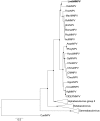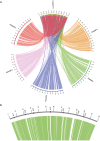The complete genome of a baculovirus isolated from an insect of medical interest: Lonomia obliqua (Lepidoptera: Saturniidae)
- PMID: 27282807
- PMCID: PMC4901303
- DOI: 10.1038/srep23127
The complete genome of a baculovirus isolated from an insect of medical interest: Lonomia obliqua (Lepidoptera: Saturniidae)
Abstract
Lonomia obliqua (Lepidoptera: Saturniidae) is a species of medical importance due to the severity of reactions caused by accidental contact with the caterpillar bristles. Several natural pathogens have been identified in L. obliqua, and among them the baculovirus Lonomia obliqua multiple nucleopolyhedrovirus (LoobMNPV). The complete genome of LoobMNPV was sequenced and shown to have 120,022 bp long with 134 putative open reading frames (ORFs). Phylogenetic analysis of the LoobMNPV genome showed that it belongs to Alphabaculovirus group I (lepidopteran-infective NPV). A total of 12 unique ORFs were identified with no homologs in other sequenced baculovirus genomes. One of these, the predicted protein encoded by loob035, showed significant identity to an eukaryotic transcription terminator factor (TTF2) from the Lepidoptera Danaus plexippus, suggesting an independent acquisition through horizontal gene transfer. Homologs of cathepsin and chitinase genes, which are involved in host integument liquefaction and viral spread, were not found in this genome. As L. obliqua presents a gregarious behavior during the larvae stage the impact of this deletion might be neglectable.
Figures






Similar articles
-
Identification and characterization of a baculovirus from Lonomia obliqua (Lepidoptera: Saturniidae).J Invertebr Pathol. 2002 Mar;79(3):137-45. doi: 10.1016/s0022-2011(02)00030-7. J Invertebr Pathol. 2002. PMID: 12133702
-
Genome sequence and organization of a nucleopolyhedrovirus that infects the tea looper caterpillar, Ectropis obliqua.Virology. 2007 Mar 30;360(1):235-46. doi: 10.1016/j.virol.2006.10.024. Epub 2006 Nov 9. Virology. 2007. PMID: 17097707
-
The genome of Dasychira pudibunda nucleopolyhedrovirus (DapuNPV) reveals novel genetic connection between baculoviruses infecting moths of the Lymantriidae family.BMC Genomics. 2015 Oct 8;16:759. doi: 10.1186/s12864-015-1963-9. BMC Genomics. 2015. PMID: 26449402 Free PMC article.
-
Lonomia obliqua Walker (Lepidoptera: Saturniidae): hemostasis implications.Rev Assoc Med Bras (1992). 2015 May-Jun;61(3):263-8. doi: 10.1590/1806-9282.61.03.263. Rev Assoc Med Bras (1992). 2015. PMID: 26248250 Review.
-
[Accidents due to lepidoptera with special reference to Lonomia sp].Medicina (B Aires). 2000;60(6):964-72. Medicina (B Aires). 2000. PMID: 11436711 Review. Spanish.
Cited by
-
The Genome Sequences of Baculoviruses from the Tufted Apple Bud Moth, Platynota idaeusalis, Reveal Recombination Between an Alphabaculovirus and a Betabaculovirus from the Same Host.Viruses. 2025 Jan 30;17(2):202. doi: 10.3390/v17020202. Viruses. 2025. PMID: 40006957 Free PMC article.
-
The Parapoynx stagnalis Nucleopolyhedrovirus (PastNPV), a Divergent Member of the Alphabaculovirus Group I Clade, Encodes a Homolog of Ran GTPase.Viruses. 2022 Oct 18;14(10):2289. doi: 10.3390/v14102289. Viruses. 2022. PMID: 36298845 Free PMC article.
-
Investigation on Pathological Aspects, Mode of Transmission, and Tissue Tropism of Antheraea proylei Nucleopolyhedrovirus Infecting Oak Tasar Silkworm.J Insect Sci. 2022 Sep 1;22(5):9. doi: 10.1093/jisesa/ieac057. J Insect Sci. 2022. PMID: 36208151 Free PMC article.
-
Impact of Lateral Transfers on the Genomes of Lepidoptera.Genes (Basel). 2017 Nov 9;8(11):315. doi: 10.3390/genes8110315. Genes (Basel). 2017. PMID: 29120392 Free PMC article. Review.
-
Genomic sequencing of Troides aeacus nucleopolyhedrovirus (TraeNPV) from golden birdwing larvae (Troides aeacus formosanus) to reveal defective Autographa californica NPV genomic features.BMC Genomics. 2019 May 27;20(1):419. doi: 10.1186/s12864-019-5713-2. BMC Genomics. 2019. PMID: 31133070 Free PMC article.
References
-
- Diaz J. H. The evolving global epidemiology, syndromic classification, management, and prevention of caterpillar envenoming. Am. J. Trop. Med. Hyg. 72, 347–357 (2005). - PubMed
-
- Carrijo-Carvalho L. C. & Chudzinski-Tavassi A. M. The venom of the Lonomia caterpillar: an overview. Toxicon 49, 741–757 (2007). - PubMed
-
- Gamborgi G. P., Metcalf E. B. & Barros E. J. G. Acute renal failure provoked by toxin from caterpillars of the species Lonomia obliqua. Toxicon 47, 68–74 (2006). - PubMed
-
- Abella H. B. et al. Manual de diagnóstico e tratamento de acidentes porLonomia.20 (Centro de Informação Toxicológica-SS/RS-FEPPS, 1999).
-
- Moraes R. H. P. Identificação dos Inimigos Naturais de Lonomia obliqua Walker, 1855 (Lepidóptera: Saturniidae) e possíveis fatos determinantes do aumento de sua população. Masters Thesis, Escola Superior de Agricultura Luiz de Queiroz (2002).
Publication types
MeSH terms
Substances
LinkOut - more resources
Full Text Sources
Other Literature Sources
Research Materials

